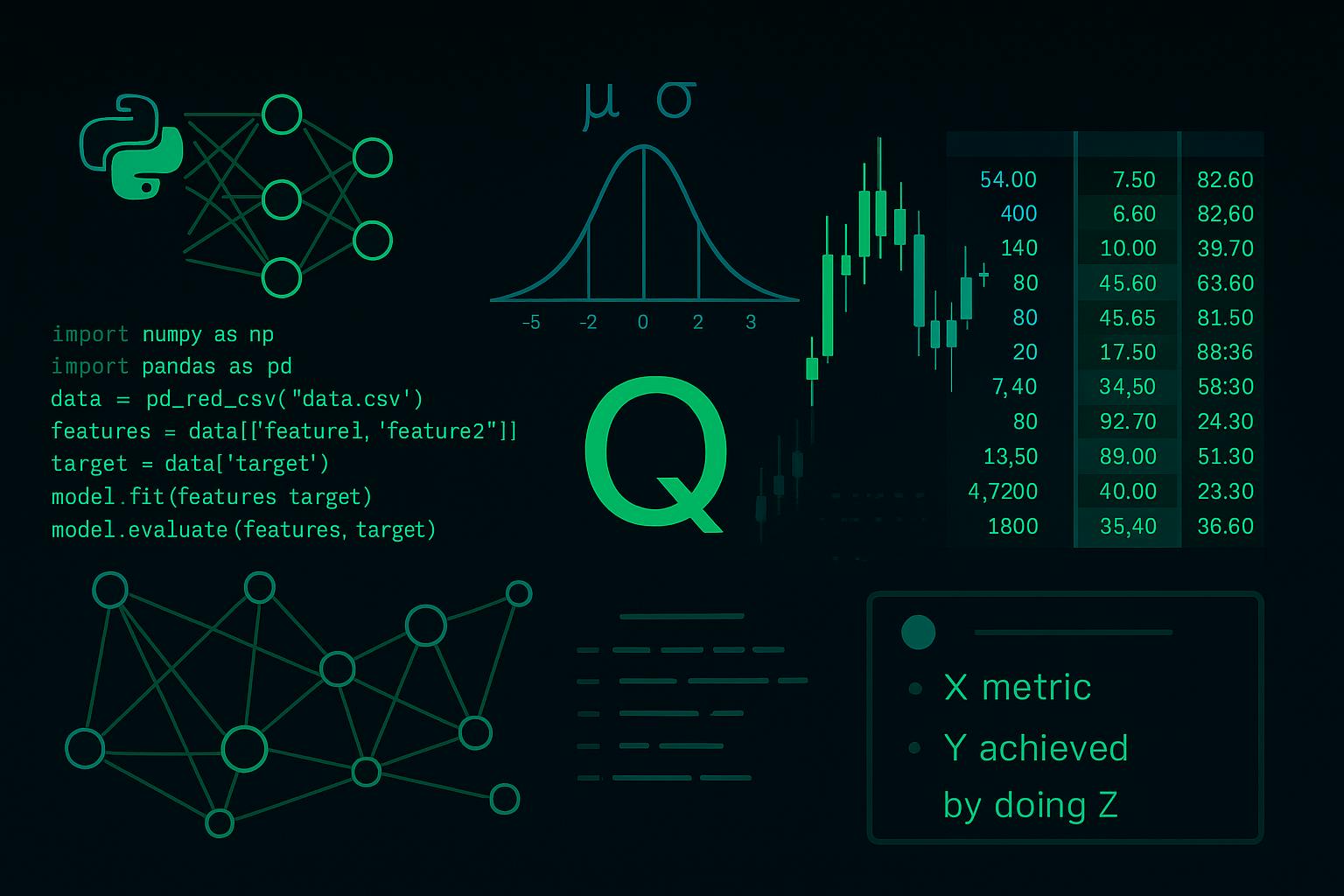Quant trading is tightly coupled with the tech industry. The talent pool is overwhelmingly STEM; the work blends data science, statistics, software engineering and systems thinking; and the field is an early, enthusiastic adopter of recent advances in machine learning and AI. If you’re comfortable in Python/C++ codebases, think in hypotheses and metrics, and enjoy building systems that respond to live signals, you’ll recognize the rhythm here. Much of what makes people effective in big-tech—clean code, profiling, reproducibility, data hygiene, infrastructure literacy—maps almost one-to-one to modern quant desks. The difference is the feedback loop: markets are adversarial, non-stationary, and unforgiving. Your models, execution, and systems are stress-tested in production every minute.
I’m a quant researcher and trader with 8+ years in the industry. People often reach out to me on LinkedIn and elsewhere asking about working in the space and how to break in. This piece summarizes what I usually tell them—condensed into one practical guide you can actually use. Most of my career has been on the buy-side, so my experience will be biased toward this space, although I will mention a few things about the sell-side too.
What you’ll get: a clear path to getting a quant trading job—role types, interview prep (coding/probability/ML/microstructure), CV/resume tips, must-read resources, and an application strategy that gets through.
The Landscape: Role Types
The exact scope of each role varies by firm and team, but I’ll outline general principles.
Quant Researcher. You work with data to form hypotheses, build predictive models, design research systems, run backtests and communicate your findings. Probability/statistics/ML fluency and ability to prototype in Python are table stakes; Java or C++ helps on some teams. You’ll turn research into production and read performance analytics to iterate. This role often does not trade directly or have direct access to production strategies (access is mediated through review/deployment processes and collaboration with traders/engineers).
Quant Trader. Somewhat similar to Quant Researcher but biased toward operating with production. You optimize fill quality, inventory risk, adverse selection, and PnL stability. Expect less time/focus on idea-driven research and more parameter governance, live monitoring, and market-aware thinking. Mental arithmetic and thinking in terms of EV (expected value) under time pressure matter. Python/SQL are used for analysis and iteration; some teams value light C++. This role involves actual trading or working very closely with production trading systems (owning parameters, supervising live behavior, and driving real-time decisions).
Software Engineer. You build research frameworks, data loaders, evaluation harnesses, and simulators. You also work on latency/jitter/throughput, exchange gateways and order-book handlers, CPU pinning, NIC tuning, performance tooling. Python appears in less latency-sensitive components, whereas Java or C++ are essential in performance-critical paths.
Pick one of these as your primary lane. Your resume, projects, and prep should make that obvious. Quant trading is a team game and rarely does one person hold (or need to hold) qualifications that combine all three. Time is finite. Even if someone could do all three roles given 3× the time, the upside justifies hiring three specialists who each excel and achieve the same in 1× the time. I like the Red Queen metaphor: you have to run fast to stay in place, and even faster to move forward.
Firm Types (and How to Aim)
Not many firms are pure examples of a particular type that I outline below and mix-types are not rare, but again, general principles usually hold.
General classification
Proprietary trading firms / HFT / Market Makers. Risk-aware PnL, reliability, and execution quality drive decisions. These shops often operate on higher-frequency horizons, trade their own capital, and favor strategies with lower capacity where speed, microstructure fluency, and robust engineering matter most.
Stat-Arb / Multi-Strat Hedge Funds. Alpha decay, capacity, portfolio construction, and rigorous validation are core. These firms typically run longer-horizon strategies, manage client assets with larger capital bases, and therefore prioritize higher-capacity signals that scale cleanly across risk limits and venues.
Banks / Sell-Side. As I come from the buy side, I won’t be focusing much on those but will mention them for completeness. Here you can expect emphasis on customer flow, risk management, and compliance constraints that would define the work; roles skew toward pricing, risk, and execution around client business. Before the 2008 global financial crisis, many banks ran prop trading; many well-known shops later spun out as independent firms due to regulatory changes.
Collaboration Models
Collaborative / Single-Book. Teams contribute to the same PnL with fewer/no walls between groups. Research efforts and trading infrastructure are widely shared. A single shared trading book to which teams contribute signals and strategies is common. Compensation often consists of base salary and discretionary bonus/profit-share. Pros: bigger group dynamics, knowledge sharing, less reinventing the wheel, more collaboration, no competition between teams as each is focused on their own domain, potentially larger combined impact, generally higher job security. Cons: individual impact can get diluted; evaluation can feel subjective/political; “jackpot” payouts are rarer as wins are socialized.
Pod structure / Siloed. A core platform (data, ordering, capital) supports independent and often competing pods that “eat what they kill”. Compensation includes a base salary (or a draw) and a formulaic payout coming from the team’s PnL. It’s not uncommon to negotiate some guaranteed payout until your pod’s strategy is up and running (may take a year or two depending on complexity). Success as a junior employee may largely depend on how lucky you are with your pod’s PM (portfolio manager/pod lead). Pros: clear attribution of impact (pod PnL), more research freedom, higher upside on take-home when you hit it big. Cons: siloing, lower job security, fewer day-to-day learning opportunities across pods, internal competition.
Pick based on risk appetite and learning style. If you like communal iteration and safety nets, collaborative shops feel better; if you want autonomy and direct attribution (and can handle variance), pods can suit you.
Trader-Oriented vs Quant-Oriented
Trader-Oriented. Traders tweak parameters and make real-time calls; quants/devs support. Compensation and PnL attribution typically skew to trader-titled roles (trader, quantitative trader, systematic trader).
Quant-Oriented. Decision-making is automated end-to-end; “live trading analysts” supervise algos, keep production healthy, and share market insights. Researchers own research-to-prod pipelines and performance analytics. Compensation/impact concentrates in researcher-titled roles (quantitative researcher, algorithm developer, research engineer).
Software/Dev in either model. You’ll work on demanding systems and can be paid at or above big-tech levels, but your roadmap follows a trader’s or researcher’s line of inquiry. Impact depends on how tightly your work binds to PnL.
Sources of Edge
- Modeling & Research. Sophisticated data analytics and predictive models that price better.
- Infrastructure & Execution. Simple signals, but you win on speed, reliability, and market access.
- Relationships. OTC/voice flow and a large, sticky counterparty/client network.
Projects & Portfolio: Why They Matter (and What Actually Signals)
The space is increasingly competitive and the abundance of candidates creates a need to make your CV stand out from the crowd. One nice way of achieving this is engaging in side project.
Hiring teams also use your portfolio to answer three questions fast:
- Can you do the work we do? Small, focused projects show you can translate an idea into code, run controlled experiments, and produce interpretable results.
- Will your work be reliable in production? Reproducibility—version-pinned environments, seeds, basic tests—signals that you won’t ship “demo-grade” artifacts.
- Will you raise the team’s bar? Clean READMEs, sensible plots, and ablations show taste and discipline. That matters as much as raw performance.
You don’t need 20 repos—you need 2–3 excellent, reproducible ones:
- A clear question (e.g., How much does queue position explain fills on illiquid pairs?).
- A minimal dataset (public or synthetic) you can share.
- A script/notebook that runs in minutes and includes basic tests.
- Plots/ablations/error bars that make results defensible.
- A README with metrics and a “5-minute run” path.
High-leverage ideas: a limit-order-book parser/simulator; an execution/participation study; a tick-data cleaning toolkit; a small backtester with stress scenarios.
Nobody expects you to publish a repo with a genius trading strategy or that your project will be immediately usable in production, but showing that your research process is robust and you are able to do directed iterations matter most.
Competitions help. Strong results in data-science contests (e.g., Kaggle) materially improve your portfolio. Competitive programming (Codeforces/ICPC) and math olympiads (IMO or national olympiads) also signal problem-solving speed, rigor, and persistence—especially early in your career. If you’ve placed well or achieved high ratings, put those front and center with dates and ranks.
Quant Resume (XYZ Formula): 1-Page Template & Examples
Your CV should be one page, focused, and scannable. Use the classic Google’s XYZ formula for bullets: Accomplished [X] as measured by [Y] by doing [Z]. It forces you to capture outcome, action, and evidence in a single line. For a quick overview from Google recruiters, see “Create Your Resume for Google: Tips and Advice” (YouTube) — https://www.youtube.com/watch?v=BYUy1yvjHxE. Even if you’re not applying to Google, these principles that your resume must follow hold in the quant space very well.
Structure that works:
- Header. Name, email, city/time zone, GitHub/portfolio link.
- Summary (optional, 1–2 lines). Lane + edge + quick proof (e.g., Market-making research; built LOB simulator—reduced adverse selection −12% in sim, validated live.).
- Experience / Projects (most space). 3–6 bullets total, each in XYZ form with metrics.
- Education. Degree, school, graduation year; key courses if you’re early-career.
- Skills. Languages (Python/C++/SQL), libraries you actually used, tooling (pytest, pandas, perf, Linux). No laundry lists.
Bullet examples (XYZ):
- Reduced adverse selection −12% by introducing a queue-aware execution policy in a limit-order-book simulator; validated over 8 weeks of live data.
- Improved backtest throughput 8× by refactoring data loaders and adding vectorized features; reduced CI runtime from 90 min → 12 min.
- Cut model latency 35% by batching inference and optimizing NumPy hotspots; maintained accuracy within ±0.2% AUC.
Formatting tips: lead with strong verbs; bold concrete metrics; link to 1–2 repos with a 5-minute run path; delete filler; proofread ruthlessly.
Quant Interview Prep: Coding, Probability, ML, Microstructure
Coding (Python/C++). Big-tech prep (e.g., LeetCode-style practice) applies. Depth maps to the role: the closer you are to software engineering or low-latency systems, the deeper the algorithms and implementation detail. For research-leaning roles, focus on stream parsing, sliding windows, graphs, heaps/deques, and numerics.
Probability & Statistics. Conditional probability, common distributions, expectation/variance tricks, estimation, hypothesis testing.
Basic Data Science & ML. Depending on scope, be comfortable with linear models, regularization, validation, and, where relevant, outline of modern deep architectures and their trade-offs. Know how to reason about bias/variance, leakage, and production validation.
Market Microstructure (for MM/HFT). Understand spread, depth, queue/priority, adverse selection, and execution tactics. For entry-level candidates, this is nice to know—it’s rarely the primary signal of problem-solving ability and will deepen on the job.
Systems. Be able to sketch a small backtester or simple feature store: interfaces, failure modes, reproducibility, test strategy, and how you’d validate results.
Brainteasers. Still common for trader roles, but rarer for researchers and developers.
Behavioral/Ownership. Big-tech playbooks transfer well: STAR-format answers, crisp post-mortems, ownership narratives, and examples of cross-team collaboration. Quant interviews often probe incidents and iteration speed—have 2–3 stories ready.
Application Strategy: How to Actually Get Through
This market is very competitive. With AI, form-based applications are noisier than ever—anyone can generate a hundred cover letters. Teams receive thousands of applications. You have to stand out.
What consistently works:
- Referrals first. Alumni, former interns, and engineers on the team. Best if they are people you actually know, but do not be ashamed of reaching out to strangers on LinkedIn working at the companies that you target—if they are confident about your background they often can refer you. Companies incentivize referrals by paying out referral bonuses that can exceed one month’s salary.
- Show up where they recruit. Find competitions they host or sponsor and try to score well. It’s a good way to stand out and land an interview. Engage at major data-science conferences. Talk to the actual engineers/researchers staffing those booths.
- Targeted headhunters. Niche recruiters who understand your lane and have direct lines into specific desks.
- Batch your search. Apply in waves of 5–7 firms; after each wave, get feedback (mocks, CV reviews), improve your materials, then start the next wave.
- Portfolio-centric outreach. Short note + one link to your best repo that runs in ~5 minutes, tailored to the team’s lane.
Think in probabilities. Don’t expect a high application-to-offer conversion unless you truly stand out (e.g., IMO winner, Kaggle GM) and you’ve prepared thoroughly.
In any case, expect to make enough applications before getting hired. It’s a probability and perseverance game in the end. If each application has a 1% chance to succeed and outcomes are independent, the chance of at least one offer after 100 applications is not even that small: 1 − (1 − 0.01)¹⁰⁰ ≈ 63.4%.
Don’t spam though—make informed improvements between waves. If you are not getting responses, try to identify reasons. Mock interviews or resume reviews by people from the industry may give great hints. Firms usually are not very generous with feedback, but try to get as much as possible.
For career-switchers
Not everyone gets into the quant industry as soon as they graduate from college. Breaking into the buy-side is not easy and may require a few iterations with cool-down periods. The space is also not that big compared to tech and is often slightly off the radar due to reduced public presence. A recent STEM graduate is more likely to target Google or Meta than Citadel or Tower Research.
However, switching between tech and quant companies usually works well. The skills you develop as a data scientist, machine learning engineer, or a software engineer working in the tech industry largely transfer with what quant researchers, traders and developers do in quant trading.
Becoming a sell-side quant and switching later to the buy-side is not an uncommon path either. Look for roles in big investment banks as a viable starting alternative.
Non-competes
It’s not exactly about breaking in, but more about how you progress. Nevertheless, I’d like to touch on this topic because, unlike other domains, it is ubiquitous in the quant trading industry. It’s better to be prepared that switching firms, in case you ever need to do it for whatever reason, may not be too easy. Be especially mindful if you relocated for your quant trading job and depend on an employer-sponsored visa.
The broader industry standard is a paid one-year non-compete, sometimes more, sometimes less. It usually means that during this year you refrain from working in another quant trading firm (subject to your current firm considering your next firm as a competitor—but a baseline assumption is that they will do so). Since in most countries it’s not legal to prevent you from working elsewhere without paying you, you will usually get your full salary for doing nothing (in the industry, people call it “gardening” or a “garden leave”) during your non-compete. Some firms may pay less than your full salary, other firms will even pay you a bonus. Be cautious with firms that impose unjustifiably long non-compete periods or have unpaid non-competes.
Another way to handle this would be to go study somewhere or work in another industry (e.g. tech/startups) during your non-compete. This can be a good opportunity to build new skills or work on something exciting (especially in these times of a rapid AI expansion when you can vibe code a working service or app in a few evenings) if you are not a big fan of growing cucumbers and tomatoes in your backyard or if you have issues with procrastination when not working in a team.
Resources & Links (with short notes)
Closing
Quant trading is a fast-paced and intellectually stimulating job. It rewards rigor, curiosity, and fast iteration. It also can pay well and let you work in an entrepreneurial environment with incredibly smart people. If you become interested in it and decide to give it a shot—pick a lane, build a portfolio that proves you can learn and ship, and practice for interviews. Then apply in waves, measure what lands, and iterate. The habits that make engineers and data scientists effective—clean code, reproducible experiments, clarity about impact—also make excellent quants. Learn how to think probabilistically about your applications and maximize your odds.










